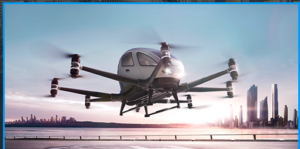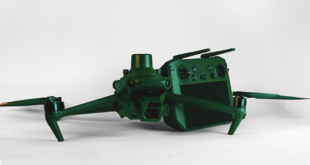Since first displaying the prototype to huge hype at CES in 2015, Chinese company eHang has created a vision of passenger taxis.
Now, Andreas Perotti of eHang says that the company has not only moved beyond prototypes and proof of concept, they’re very close to full commercial applications. In China, where regulations allow, thousands of flights are taking place safely. The manufacturing for the vehicle is established and ready to go. Most importantly, the company has lined up thousands of customer pre-orders.
eHang’s Zero model functions like most taxis do – it carries two people, with luggage: about average for most hired modes of transportation. Perotti says that the company’s vision is of a vehicle that makes the sky very accessible. “We want to provide the benefits of a helicopter – for everyone,” Perotti says. “We don’t want to build a toy for rich people. We want to make it available for everyone to use.”
That means that both hardware and software development needs to be optimized. “The whole process chain needs to be very lean to make it affordable,” says Perotti. While the current model will sell for about 300,000 Euro, Perotti says that the next versions could be sold for the same price as an expensive sports car – making it possible for operators to sell the service at a reasonable price.
While there are multiple players in the passenger drone space, eHang is one of the first. Perotti says that at this stage of the market, Urban Air Mobility ompanies need to work together. “It’s far too early to talk about competition,” he says. “There is no market yet. We need to all pull together on one string to make this happen.” While the concept of passenger drones has been around for decades, the time has finally come for real production and implementation. “This is not a new conversation,” says Perotti. “But we have the core technologies in place now to make it possible.”
The aircraft are ready. The software and the hardware exist. But in order for passenger taxis to scale, more is needed. “We need the ecosystem – the takeoff and landing infrastructure, the maintenance infrastructure, the regulations. These are problems. But they are solvable,” says Perotti. While the product already exists, regulations and public perception have the potential to slow adoption. Fixing that will take the cooperation of everyone in the drone industry, regulators, and media, Perotti comments. “We need to take everyone with us on the journey of urban air mobility,” says Perotti.
Miriam McNabb is the Editor-in-Chief of DRONELIFE and CEO of JobForDrones, a professional drone services marketplace, and a fascinated observer of the emerging drone industry and the regulatory environment for drones. Miriam has a degree from the University of Chicago and over 20 years of experience in high tech sales and marketing for new technologies.
Email Miriam
TWITTER:@spaldingbarker
Subscribe to DroneLife here.
https://dronelife.com/2019/12/04/ehang-getting-close-to-commercial-applications-in-drone-taxis/
 Unmanned Aerial Vehicle The latest drone news
Unmanned Aerial Vehicle The latest drone news





